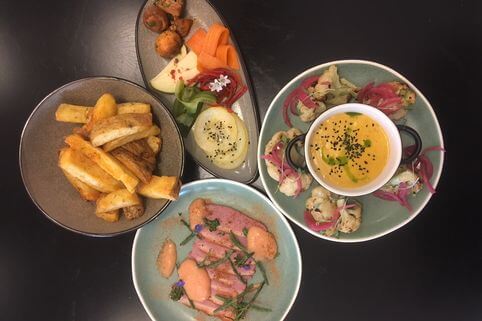Sameer Sarmast’s adventurous urge for food, long in the past, moved beyond his mother’s South Asian cooking. Instead, he likes highly spiced enchiladas, Jamaican jerk chicken, Texas-style barbecue, and Philly cheesesteak sandwiches.
But one aspect hasn’t been modified. He nevertheless continues to follow the dietary tips determined using his Muslim family, which, amongst different matters, forbid alcohol and red meat and require the prayerful slaughter of animals. And at the same time, as finding ingredients licensed as halal (translated to “approved”) as soon as required, a journey to distinctiveness grocers in Muslim-majority neighborhoods, many of those meals can now be discovered from Maine to Hawaii.
“The component approximately halal is, you could cater to any demographic,” Sarmast says. “It can be halal Mexican, halal Chinese, halal Greek. If you cater to distinct humans, unique cuisines, you’ll entice a crowd.”
Sarmast is a Muslim of Indian descent, and he’s at the leading edge of a collection of social influencers who are expanding that crowd. Through famous blogs, videos, and social media, those Muslim Americans seek to bring halal far from just the meals truck, road supplier’s cart, and faith-led kitchen. These new halal foodies, or self-defined “hoodies,” have contributed to an increase that is attracting non-Muslims to halal ingredients in their favorite eating places and their homes. It’s also leading a few Muslims to question whether or not the essence of the practice is being misplaced within the technique.
“It’s a place of gratitude—gratitude for the animal for making the sacrifice of its life, and gratitude to Allah for allowing me to devour this meat.” “Halal isn’t always just a meal cart,” says Sarmast, who hosts Sameer’s Eats, a video blog wherein tens of thousands of humans watch him visit New York-area eateries to sample pizza, soul food, or even bacon made from pork or turkey. “Now, non-Muslims are announcing, ‘Wow, I gotta get a bit of that burger.’”
Besides Sameer’s Eats, other famous halal meals blogs consist of Amanda’s Plate via Seattle’s Amanda Saab; My Halal Kitchen using Chicago’s Yvonne Maffei; Zabihah by way of Washington, D.C.’s Shahid Amanullah; and Chicago-based Malika Ameen’s eponymous site. These sites provide restaurant and meal evaluations, recipes, and advise alternative components to make and, in any other case, “haram,” or forbidden, meals halal.
The practice requires that animals be slaughtered by way of an educated and certified working towards Muslim, who must recite the call of Allah earlier than making a single reduce across the animal’s throat. Besides the ban on alcohol and beef, Muslims trying to consume the simplest halal meals need to avoid gelatin, enzymes, emulsifiers, and a few flavorings if they can’t be sure their origins are halal. Animal antibiotics and hormones are also out. Genetically modified meals and elements are generally suited if engineered from halal organisms, but not if animals suffered from their making.
Many Muslims keep in mind that ingesting halal essential part of their relationship with God. “There is the sacrifice, aim, and cognizance” to halal meals, says Maffei, who writes My Halal Kitchen from Chicago and Turkey and publishes a cookbook by the identical name in 2016. “The system could be very intentional and is dedicated to God. It’s a way we can feel excellent approximately what we’re ingesting.” Zabihah, the call of Amanullah’s website, refers specifically to pointers for slaughtering animals. The website offers a halal eating place and meal reviews to twenty million specific users around the world annually. For him, halal is largely about thoughtful intentionality.
“The first time I saw halal slaughter, it made me conscious,” Amanullah says. “Now I pause after I eat meat. It’s a place of gratitude—gratitude for the animal for making the sacrifice of its life, and gratitude to Allah for permitting me to devour this meat.” Maffei, who transformed to Islam as a person, believes interest in halal foods blossomed partly due to a growing interest in eating “smooth” foods beyond the Muslim community. When she promoted her cookbook, she said that more non-Muslims than Muslims came to listen to her speak.
“I suppose it’s far due to the transparency aspect,” Maffei says. “When you talk about halal meals, you are talking about what’s inside the meals. Consumers recognize that if they buy a halal product, they recognize what’s in it.”
Bloomberg figures the U.S. Halal marketplace makes up $20 billion of that yearly, up from $15 billion a few years ago. Adnan Durrani, founder and CEO of The American Halal Company, says that 80 to eighty-five percent of individuals who purchase his employer’s famous Saffron Road halal food products are non-Muslim. Halal is their manner of identifying with a “meals tribe” or network.
“They see halal as a journey to better values, to moral consumerism, and higher surroundings,” he says. That adventure is contemplated in Saffron Road’s success. Since its founding in 2010, the Connecticut-based business enterprise has grown to offer 70 products carried by 20,000 retail outlets with $45 million in annual sales. On the menu is the whole lot from chicken tenders to chicken tikka masala.
The normal halal grocery store is growing, as well. Thomson Reuters estimates the worldwide halal market at $1.Eight trillion this year, and Bloomberg figures the U.S. Halal market makes up $20 billion of that yearly, up from $15 billion some years ago. American stores from Whole Foods to Walmart now bring halal meat, prepared foods, and fitness and beauty products. Saffron Road’s Durrani tags millennials because of the chief drivers of that increase.
“They are multicultural and adventurous,” he says. “And they’re various and progressive, more likely to come back into contact with Muslims and recognize halal ingredients than the technology earlier than them. So halal meals in shape right into their cost gadget, whether or not they’re Muslim or not.”





